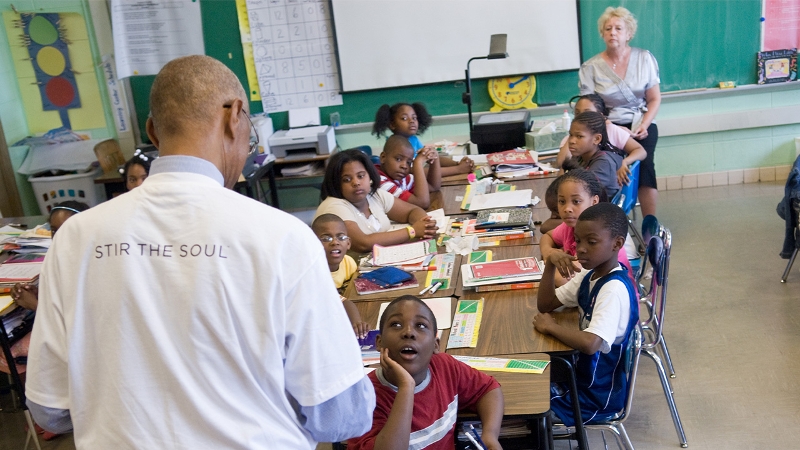Enroll in Primary Science Tuition Singapore for a Strong Science Foundation
Enroll in Primary Science Tuition Singapore for a Strong Science Foundation
Blog Article
A Comprehensive Guide to the Numerous Understanding Methods in Main Science Guideline
The expedition of diverse understanding techniques in key science direction presents an opportunity for teachers to enhance pupil engagement and comprehension significantly. By checking out hands-on understanding strategies, inquiry-based techniques, and collaborative methods, we can determine effective techniques that satisfy various learning designs. In addition, the integration of innovation and distinguished direction plays an important role in fostering an inclusive atmosphere. The concern remains: just how can these techniques be successfully executed in the classroom to optimize their impact? The answer depends on a more detailed assessment of each technique and its ramifications for training scientific research.

Hands-On Learning Techniques
Hands-on discovering techniques play a pivotal function in key science direction, engaging pupils in active expedition and testing. These techniques enable learners to engage straight with materials and phenomena, cultivating a deeper understanding of clinical ideas. By using manipulatives, designs, and real-life experiments, instructors develop an atmosphere where trainees can observe, hypothesize, and check their ideas.
Such methods not just enhance understanding but also grow important thinking and analytic skills. When students take part in tasks like building simple devices, growing seeds, or performing chemical responses, they are encouraged to ask concerns and look for solutions through their very own observations. This experiential technique assists to debunk complex scientific principles, making them much more accessible and relatable.
Moreover, hands-on knowing advertises cooperation amongst peers, as trainees often function in groups to carry out experiments or share findings. This teamwork not only enhances their understanding experience but likewise creates vital social skills. Eventually, incorporating hands-on techniques in main scientific research instruction promotes a lifelong love of understanding and curiosity about the environment, laying a strong structure for future scholastic pursuits in science and beyond.
Inquiry-Based Discovering
Inquiry-based knowing is an instructional method that motivates trainees to ask questions, explore sensations, and build their own understanding of scientific principles. This method changes the focus from traditional teacher-led direction to a much more student-centered experience, where students take the campaign in their educational journey. By cultivating interest, inquiry-based knowing promotes much deeper interaction with the material, enabling pupils to discover topics in a meaningful context.
In method, this method usually includes hands-on experiments, monitorings, and essential reasoning tasks that straighten closely with the clinical technique. Students are encouraged to develop hypotheses, layout investigations, and analyze information, which grows essential abilities such as analytic and logical thinking. The function of the teacher in this structure is to assist in expedition, leading students via the questions process while motivating independent thought and cooperation.
Moreover, inquiry-based understanding nurtures a feeling of possession over the understanding procedure, inspiring pupils to seek understanding proactively. This technique not only improves understanding of scientific concepts yet additionally cultivates a lifelong love for discovering, gearing up students with the abilities essential to navigate a significantly complicated globe.
Collaborative Learning Approaches
Collaborative learning strategies equip pupils to take part in purposeful communications with peers, promoting a common responsibility for their academic end results. In primary scientific research direction, these methods motivate learners to interact to explore clinical ideas, address issues, and conduct experiments (primary science tuition Singapore). By joining team tasks, trainees can utilize varied point of views, permitting richer understanding and retention of scientific understanding
One trick aspect of joint knowing is the emphasis on interaction skills. Students have to verbalize their thoughts, pay attention actively to others, and discuss ideas, every one of which are critical competencies in both academic and real-world contexts. This social interaction not only improves their understanding of clinical principles but likewise advertises synergy and dispute resolution abilities.
Additionally, joint discovering usually leads to increased motivation next page and interaction. They are much more likely to take possession of their knowing trip when trainees see the worth of their contributions within a team. Teachers can promote this process deliberately structured team tasks that align with curriculum objectives while supplying advice on effective collaboration strategies. In general, integrating joint learning approaches in primary scientific research direction grows a dynamic knowing atmosphere that prepares pupils for future scholastic and social difficulties.
Modern Technology Combination in Science
The assimilation of technology in primary science direction enhances discovering experiences by giving innovative tools and sources that support various teaching techniques, consisting of collaborative understanding - primary science tuition Singapore. Making use of electronic systems, simulations, and interactive applications permits pupils to engage deeply with clinical concepts, assisting in a more hands-on strategy to understanding
Virtual labs, for circumstances, allow learners to perform experiments securely and successfully, advertising inquiry-based knowing. These tools can mimic real-world scientific scenarios, enabling trainees to imagine complex processes that would be challenging to reproduce in a standard class setting. Moreover, technology promotes interaction and collaboration among trainees, as they can share searchings for and interact on tasks via on the internet platforms.
Furthermore, multimedia presentations and educational video clips can improve lessons by dealing with diverse understanding styles, making abstract concepts much more easily accessible. Information evaluation tools additionally empower students to gather and translate clinical data, enhancing vital believing abilities. Generally, the tactical incorporation of modern technology in primary scientific research direction not only enhances interaction but also prepares pupils for a highly sophisticated culture, outfitting them with essential skills for future scientific ventures.
Differentiated Instruction Approaches
Differentiated instruction methods are important for resolving the varied needs of learners in primary scientific research education. These approaches visit this site right here make it possible for instructors to tailor their mentor approaches to suit differing capacities, rate of interests, and finding out styles within the class. By using differentiated guideline, educators can develop a comprehensive setting that cultivates engagement and improves understanding of scientific concepts.
One effective method is to make use of flexible grouping, which enables students to team up with peers at comparable ability levels or with varying viewpoints. This approach motivates peer discovering and advertises vital thinking. In addition, providing selections in projects can empower pupils, enabling them to choose jobs that resonate with their passions while still meeting curricular purposes.
In addition, including tiered jobs is an additional beneficial strategy. Deliberately jobs with varying degrees of intricacy, educators can make certain that all pupils are suitably tested, despite their effectiveness. Using developmental assessments to assess comprehending additional enables instructors to adjust their instructional methods dynamically, making sure that each student obtains the support they need.
Inevitably, implementing separated direction methods in primary scientific research education not only enhances pupil learning end results yet also grows an interest for science, preparing trainees for future scholastic searches.

Conclusion
In summary, reliable primary scientific research guideline necessitates a complex method that incorporates hands-on knowing, inquiry-based methods, and joint methods. The combination of modern technology and distinguished direction additionally accommodates varied understanding styles, fostering an environment for expedition and crucial reasoning. By executing these techniques, teachers can improve trainee engagement and comprehension, eventually supporting a long-lasting interest for scientific research and query. Such comprehensive my review here techniques are necessary for creating educated and interested future scientists.
The expedition of diverse knowing techniques in primary scientific research instruction provides an opportunity for instructors to improve pupil involvement and understanding substantially.Hands-on understanding methods play a pivotal function in key science instruction, engaging students in active exploration and experimentation.Inquiry-based understanding is an educational method that urges students to ask concerns, explore sensations, and construct their own understanding of clinical concepts.Collaborative discovering strategies empower students to engage in meaningful interactions with peers, fostering a shared responsibility for their educational end results. On the whole, including joint understanding strategies in main scientific research direction cultivates a dynamic knowing environment that prepares pupils for future scholastic and social difficulties.
Report this page